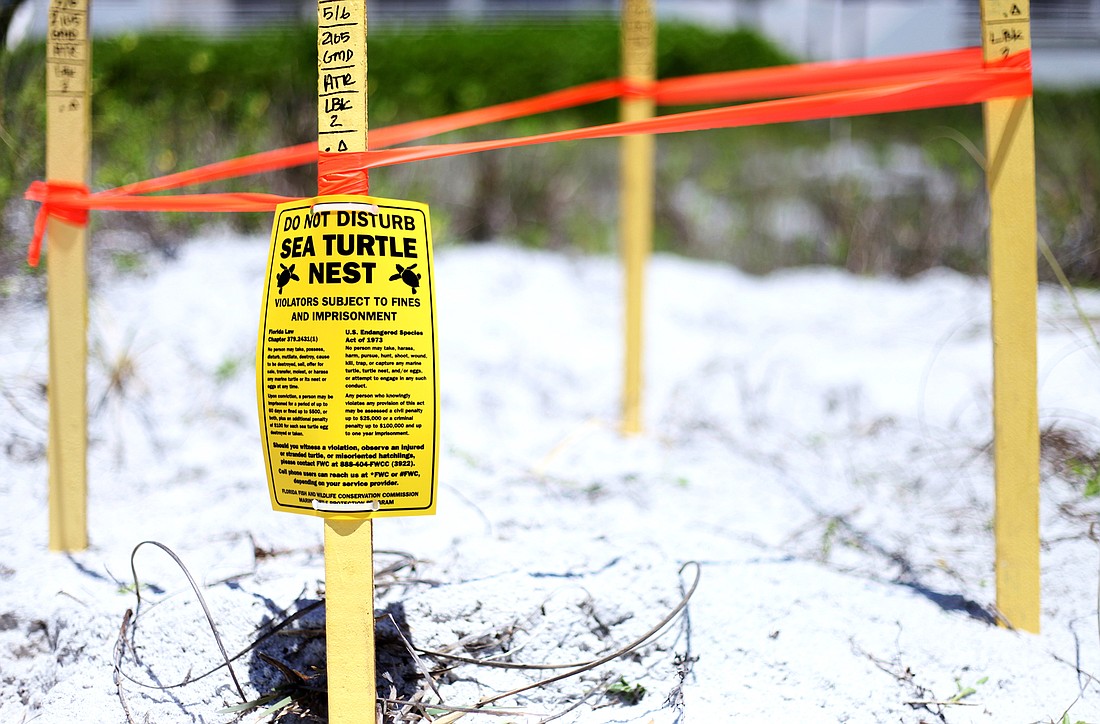- July 26, 2024
-
-
Loading

Loading

As the snowbirds of Longboat flock home, new island residents will swim in to take their place: turtles.
Turtle nesting season begins May 1 and continues through October. Each year turtles lay more than 2,000 nests from Longboat Key to Venice. Last year’s season was especially active with 2,461 nests — just eight nests fewer than the record-high nesting season of 2012.
Nesting season, however, wouldn’t be successful without the help of volunteers with Mote Marine Laboratory and Aquarium and Longboat Key Turtle Watch.
Currently, 324 volunteers work with Mote’s Sea Turtle Conservation and Research Program, and 30 work with Longboat Key Turtle Watch. Every morning, volunteers patrol beaches to look for turtle tracks and nests.
“We usually have two to four people walking about a mile and a half,” Turtle Watch Vice President Cyndi Seamon said. “It’s camaraderie. People get to know people with like-minded interests. Everyone has to go through a training process.”
Residents and visitors must do their parts as well.
“People need to know to turn out the lights on the beach and to close their drapes,” Seamon said. “If you’re a little turtle coming out of the nest and see the building with the lights on, which way will you go? You’d go toward the light. Our disorientation rates are pretty high, and that’s not something to be proud of.”
On Longboat Key, 30% of hatchlings experienced disorientation last year. Disorientation rates were 32% on Lido Key, 20% on Siesta Key, 15% in Venice and 3% on Casey Key.
“Disorientations are caused by artificial lighting,” said Hayley Rutger, public relations manager at Mote. “Sea turtles normally head toward the brightest horizon to reach the sea, and on a natural beach, the ocean horizon is brightest, but the turtles can head in the wrong direction and potentially into harm’s way if artificial lights are visible from the beach or if inland artificial lights are creating sky glow.”
“It’s camaraderie. People get to know people with like-minded interests. Everyone has to go through a training process.” — Turtle Watch Vice President Cyndi Seamon
Seamon said the people who don’t follow protocol are typically those who aren’t familiar with it.
“Property managers are really, really good and understand it,” Seamon said. “Some of the new homeowners or hotel guests have never been exposed to it, so if there’s a new house the developer or builder will educate them a little bit.”
Hatchlings aren’t the only turtles affected by bright lights. False crawls among nesting turtles are also common.
“A false crawl happens when an adult female sea turtle crawls up the beach to nest but returns to the ocean without leaving a nest,” Rutger said. “A turtle may false crawl if she is disturbed by people, lights or obstacles on the beach, such as furniture. That means it’s very important to give turtles their space and keep beaches clear of obstacles.”
The majority of nests in the area are laid by loggerhead turtles, but occasionally green sea turtles and Kemp’s ridley sea turtles nest on local beaches.
Hatchlings reach sexual maturity at approximately 25 years and will return to the same beach on which they hatched to nest themselves. Mature female loggerhead turtles return to nest every two to three years.
“Most people I talk to are fascinated by sea turtles, and Florida has 90% of the world’s population of loggerheads,” Seamon said. “The cool thing is that we get to share the beach with this amazing sea turtle that’s been around for millions of years and has been doing this thing for millions of years.”